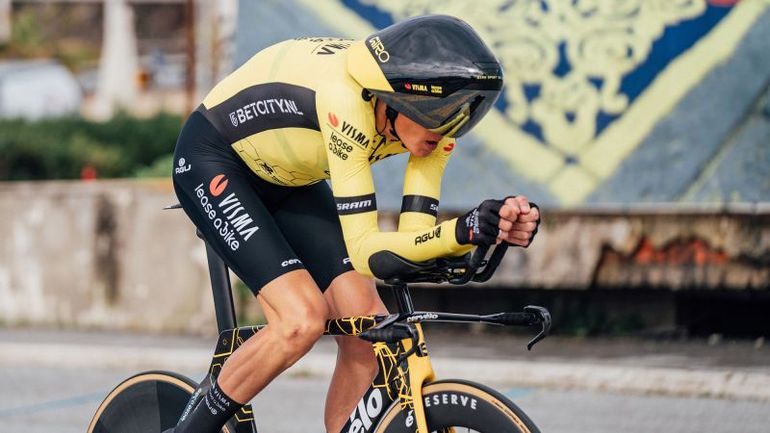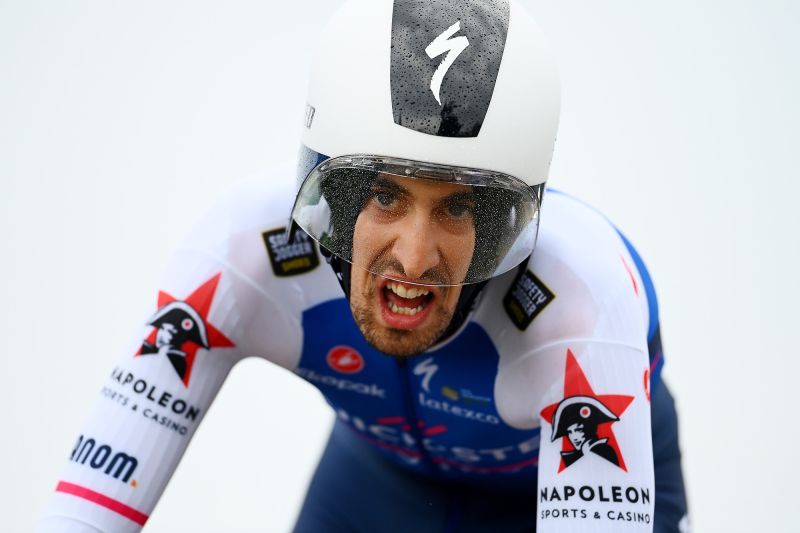
Controversial Cycling Helmet Design Faces Scrutiny from Regulatory Body

Comparisons to sci-fi movies and mixed opinions on aesthetics surround a cutting-edge cycling helmet design currently under evaluation by a governing body. A prominent cycling team anticipates significant performance enhancements in time trials with this bold and futuristic helmet.
Some onlookers have compared a new bulging cycling helmet to something from Star Wars, while others simply find it unattractive. However, a top cycling team is optimistic that its futuristic design will greatly enhance time trial performance.
The design must first be approved by the Union Cycliste Internationale (UCI), the global governing body for cycling.
Team Visma-Lease a Bike riders unveiled the new large helmet during the Tirreno-Adriatico prologue in Italy. The Aerohead II helmet, made by Giro, features a noticeably big front end that is nearly as wide as a rider's shoulders.
Despite the helmet's unique design drawing comparisons to stormtroopers and aliens on social media, Visma-Lease a Bike is optimistic that it will help riders improve their performance in time trials.
"We are thrilled with the collaboration with Giro, there have been no limits to our partnership," expressed Paul Martens, the team's head of rider apparel, in a video shared on X, previously known as Twitter.
Martens further explained, "The change in appearance is evident. It's a fresh perspective on the aero helmet, and we strongly believe that we have made significant enhancements from our previous system in the time trials. We are excited to showcase it today."
Jonas Vingegaard, the Tour de France champion, represented Visma-Lease a Bike in Monday's time trial. He placed ninth, finishing 22 seconds behind the winner Juan Ayuso from UAE Team Emirates.
The helmet stirred up controversy when it made its debut at the race.
Eurosport commentator Robbie McEwen expressed his strong disapproval, calling the helmets a distraction and stating that he does not support them.
Visma-Lease a Bike expressed their satisfaction with the new aerodynamic design of the helmet on their website. They also mentioned that the helmet meets all current safety regulations.
On Tuesday, the UCI brought up the new design when they announced that they will be reviewing their rules regarding helmets in competitions.
The statement acknowledges that although this may not directly violate current UCI Regulations, it does bring up a significant concern about the current trend in time trial helmet design. The focus seems to be more on performance rather than the main purpose of a helmet, which is to ensure the safety of the wearer in case of a fall.
The statement also specifically mentions two helmets under review: the Rudy Project Windgream HL 85 helmet, used by the Bahrain Victorious team, and the POC Tempor helmet, worn by several teams.
The UCI has announced that they will be reviewing their rules on helmet design and use in competition. This decision comes after facing various challenges and issues in recent years, such as ensuring commercial availability and regulating non-essential components, as well as the shape and size of time trial helmets.
Additionally, the UCI stated that starting next month, "head socks" - balaclavas integrated into cycling helmets - will no longer be allowed at international events.
Italian rider Mattia Cattaneo wears a "head sock" during the Tour de France in July 2022.
Italian rider Mattia Cattaneo wears a "head sock" during the Tour de France in July 2022.
The ban on the TT5 helmet, made by Specialized, will start on April 2. It was put in place after a review to see if the helmet met the UCI’s rules for equipment.
During the review, it was determined that the head sock was not necessary.
The TT5 helmet made its debut at the Tour de France in 2022, as reported by Cyclingnews, and has been consistently used ever since.
Wacky helmet designs are a common sight in cycling, where athletes are always trying to improve their aerodynamics during races. The UCI, which sets rules for helmets, requires that any helmet used by pro riders must be sold to the public as well.
CNN reached out to Specialized, Visma-Lease a Bike, Giro, and Rudy Project for their thoughts on the UCI's examination of helmet designs.
Editor's P/S:
The article highlights the debate surrounding the design of cycling helmets, with some hailing the futuristic Aerohead II helmet as a potential performance enhancer while others criticize its aesthetics and safety concerns. The UCI's decision to review helmet regulations underscores the need to balance innovation with rider protection. The ban on the Specialized TT5 helmet and head socks further demonstrates the UCI's commitment to ensuring helmets meet both safety and regulatory standards.
Personally, while I appreciate the pursuit of aerodynamic advancements, I believe safety should remain paramount in helmet design. Helmets are essential protective gear in the event of a fall, and their shape and size should prioritize rider well-being over marginal performance gains. I hope that the UCI's review will lead to a balance between technological innovation and the fundamental purpose of helmets: to protect riders in case of an accident.







